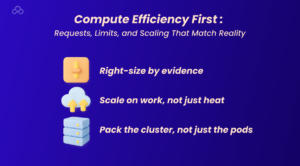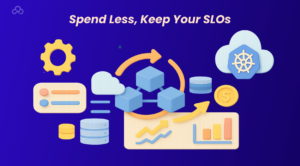Kubernetes gives you scale, portability, and self-healing, but it will also cheerfully burn your budget if you let defaults run the show. The trick isn’t a thousand toggles; it’s a small set of disciplined moves that align engineering choices with cost signals. A mature cloud based DevOps practice treats cost as an SLO-adjacent metric: observable, reviewable, and owned. Below is a concise playbook focused on high-leverage actions, the cloud DevOps best practices behind them, and where a seasoned cloud based devops engineer (or trusted cloud and devops services partner) fits.
Compute efficiency first: requests, limits, and scaling that match reality

Most waste starts at the pod spec. Requests are set “just in case,” limits are infinite, and autoscaling chases the wrong signals. Fixing these three items typically unlocks the largest savings with the least drama.
Right-size by evidence.
Capture 7–14 days of CPU/memory and workload metrics (cAdvisor/metrics-server/Prometheus). Set requests around the P60–P70 of observed usage for steady services; set limits to roughly 1.25–1.5× unless the workload truly needs burst headroom. For campaign spikes or seasonal bursts, use a higher percentile (P80–P90) for the window in question, then revisit.
Scale on work, not just heat.
CPU is easy to read, but not always the right proxy for load. If your service consumes from a queue or processes events, the Horizontal Pod Autoscaler should key off queue depth or a custom SLI, not only CPU. Keep Vertical Pod Autoscaler in recommendation mode at first to spot chronic over/under-allocation before you lock in values. Where traffic is highly bursty, KEDA (event-driven autoscaling) prevents idle replicas from hanging around between bursts.
Pack the cluster, not just the pods.
Even perfect pods waste money on poorly chosen nodes. Use Cluster Autoscaler or Karpenter to align node shapes with workload patterns, larger nodes often improve bin-packing for CPU-heavy services, while smaller nodes scale down faster for memory-bound or spiky apps. Calibrate topology spread constraints so resilience is preserved without stranding capacity. Critical paths should receive PodPriority; background tasks should gracefully yield.
Rightsizing Quick Guide
|
Pattern |
Requests target |
Limits target |
Notes |
|
Stable backend |
P60–P70 |
1.25× |
Default for steady services |
|
Promotion spike |
P80–P90 |
1.5× |
Revert post-event |
|
Batch/cron |
P50 |
1.2× |
Prefer node isolation for noise control |
Note: A SaaS team that shifted HPA from CPU to queue depth cut requested CPU by ~32% with no SLO regressions, netting ~18% monthly savings. That’s textbook cloud DevOps best practices, measure, right-size, observe, adjust.
Smarter capacity: mix on-demand and spot without introducing chaos
Spot/preemptible capacity is the most obvious discount in the cloud. Used carelessly, it’s also the fastest way to create 3 a.m. pages. The middle ground is straightforward:
1. Put control planes and critical, latency-sensitive paths on on-demand nodes.
2. Run stateless workers, media transcoders, ETL, and other retry-friendly tasks on spot across multiple instance types and AZs to reduce correlated interruptions.
3. Define PodDisruptionBudgets so voluntary or involuntary evictions don’t drop availability below your threshold.
4. Implement graceful termination (SIGTERM handling and terminationGracePeriodSeconds) so pods finish useful work before exit.
5. Keep a fallback class of nodes that can absorb a partial spot failure without overshoot.
Moving a video processing pipeline’s workers to spot, with sane PDBs and retries, increased interrupts but dropped compute cost ~44%. A devops cloud engineer orchestrated the mix and tuned backoff policies until error budgets were untouched.
Data plane costs: storage, logs, tracing, and egress (the quiet spend)
Storage and observability often eclipse compute in mature clusters. The fixes are procedural and boring, which is why they work.
Persistent volumes.
Choose StorageClasses to match I/O needs, don’t mount io-optimized SSDs for cold volumes. Apply retention policies to CSI snapshots, and sweep orphaned PVCs after rollouts. Many teams recover 10–20% of storage spend by cleaning up alone.
Logs and traces.
Sample at the edge, drop DEBUG in production, and shorten retention where compliance allows. Compress aggressively. Move high-volume traces to cheaper tiers after 7–14 days. A lightweight forwarder (Vector/Promtail/Fluent Bit) can filter before indexing, which saves you double, on ingestion and storage.
Network egress.
Keep east-west traffic on internal load balancers; only pay for public egress when traffic truly leaves the VPC. Cache near clients (CDN/edge) to reduce origin pulls. If you rely on a service mesh, weigh the sidecar tax (CPU/RAM per pod). In large clusters, eBPF-based or sidecar-less meshes reduce overhead and unlock capacity.
Storage & Logs Quick Wins
|
Area |
Tactic |
Typical impact |
|
PVC lifecycle |
TTL snapshots + PVC sweeper |
10–20% storage cut |
|
Log volume |
Structured sampling, drop DEBUG |
25–50% ingest cut |
|
Traces |
Cold-tier after 7–14 days |
30–40% APM cost cut |
|
Egress |
Internal LBs + CDN |
15–25% egress cut |
A fintech moved service-to-service calls behind internal LBs and trimmed egress ~22% without touching app code, simple architecture, measurable payoff.
Brief real-world outcomes
Here are three quick, real examples that show what steady, boring discipline can do, no magic, just habits.
1. Retail SaaS (EU/US). After two weeks of telemetry, the team set requests around P70 and switched to canary rollouts instead of blue/green. They also pushed east–west traffic behind internal load balancers. Result: about 37% less compute and 22% less egress, with zero SLO impact.
2. Streaming ETL. They ran a mixed pool of spot and on-demand nodes across multiple AZs, added PodDisruptionBudgets, and tuned retries. Compute spend dropped roughly 44%, and the error budget stayed green.
3. Fintech core services. By introducing log sampling and tightening retention, the observability bill fell about 41% while MTTR and coverage held steady.
These wins are repeatable because they rely on clear signals and small guardrails. With a steady devops cloud engineer (or a disciplined cloud based DevOps team) minding the dials, results like this become the norm.
Technical FAQs
HPA vs VPA vs Cluster Autoscaler, what’s the right mix?
– HPA adds/removes pods in response to load (CPU, QPS, custom SLI).
– VPA recommends/adjusts pod resources when usage is chronically off.
– Cluster Autoscaler/Karpenter adds/removes nodes to fit the scheduled pods.
Use HPA for short-lived spikes, VPA to correct mis-sizing, and a cluster autoscaler to align node count and shape with demand. This triad is standard in cloud DevOps best practices.
Are spot/preemptible nodes safe for production?
Yes, when you confine them to stateless and retry-tolerant workloads, set PodDisruptionBudgets, implement graceful termination, and spread across instance types/AZs. Keep critical paths on on-demand. A pragmatic devops cloud engineer for cloud based devops will tune backoff and retry so error budgets stay green.
How do we compute “cost per request” in Kubernetes?
Use an allocation tool (OpenCost/Kubecost) to assign node, storage, and LB costs to namespaces/workloads, then divide by the request count (or business event). Put that next to P95 latency and error rate on a shared dashboard. It’s the simplest way for cloud based devops and devops services teams to align engineering with finance.
Our service mesh is expensive, should we drop it?
Meshes bring mTLS, retries, and traffic shaping, but sidecars add CPU/RAM overhead. If sidecar cost exceeds the value for most services, consider eBPF/sidecar-less approaches or scope the mesh to the few services that truly need it. Evaluate with real cost and SLO data, dogma helps no one.
What’s the fastest storage win?
Delete orphaned PVCs and shorten snapshot retention. Then right-size volumes and move old traces/logs to colder tiers. In many cloud based DevOps audits, those three actions produce double-digit percentage savings in a week.
Which single devops tool should we standardize on for cost visibility?
Standardize on one allocation layer (OpenCost/Kubecost) and one APM. Enforce label hygiene and publish a single, shared dashboard. Tool sprawl erodes signal and adds its own hidden cost.
Spend Less, Keep Your SLOs

Cost optimization in Kubernetes isn’t a one-off campaign; it’s a rhythm. Right-size based on evidence, autoscale on real work, pack nodes intelligently, and reserve spot for the jobs that can tolerate it. Rein in storage, logs, and egress with simple rules, then turn those rules into guardrails so savings persist. Finally, make cost per request visible on the same dashboard as latency and error rate. That’s how a cloud based DevOps team cuts spend and keeps reliability, no gimmicks, just cloud based DevOps best practices implemented with the right devops tool choices and steady ownership from an experienced devops cloud engineer or cloud and devops services partner.
Do you like to read more educational content? Read our blogs at Cloudastra Technologies or contact us for business enquiry at Cloudastra Contact Us.